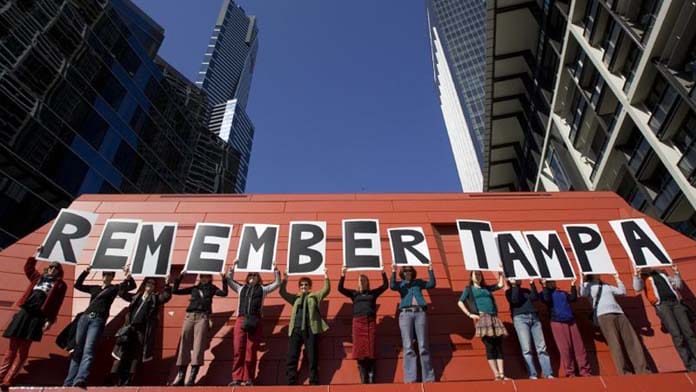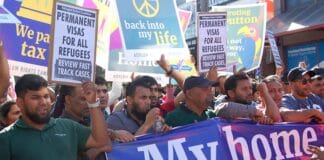Twenty years ago this month, the ‘Tampa affair’, a flash point in John Howard’s militaristic and xenophobic response to refugees arriving by boat, made the demonisation of refugees central to Australian politics, writes Mark Goudkamp
On 24 August 2001 the Palapa, a small Indonesian fishing boat overloaded with 433 asylum seekers, faltered in international waters about 140 kilometres north of Christmas Island.
Two days later, Arne Rinnan, captain of the Norwegian cargo ship MV Tampa, responded to a distress call from the Australian Rescue Coordination Centre while en route from Fremantle to Singapore. Australia had wanted Indonesian search and rescue to deal with the situation, but the Tampa arrived at the sinking boat first, and commenced a rescue operation that continued all afternoon. Makeshift accommodation and bathrooms were set up on the open deck.
Rinnan later told Norway Today: “When we arrived it was obvious to us that it was coming apart. Several of the refugees were obviously in a bad state and collapsed when they came on deck to us. Ten to 12 of them were unconscious, several had dysentery and a pregnant woman suffered abdominal pains.”
Australia instructed Rinnan to transport his human cargo to the Indonesian port of Merak, 11 hours away, but a delegation of desperate asylum seekers convinced him to head for Christmas Island, which was much closer.
The Australian government threatened to prosecute Rinnan for people smuggling and to fine him $110,000 if he entered Australia’s maritime zone. Howard insisted that no asylum seeker on the Tampa would set foot on Australian soil. Two months before Howard’s infamous boast, “We will decide who comes to this country”, he said he wanted to, “draw a line on what is increasingly becoming an uncontrollable number of illegal (sic) arrivals in this country.”
Many of the asylum seekers on board were ill. Over the next 48 hours,
Rinnan made repeated requests to the Australian authorities for help. On 28 August, the Flying Doctor Service reported a “mass situation medical crisis”—including 15 unconscious, sick children, pregnant women, and hunger strikers suffering stomach pain and diarrhoea.
Rinnan declared an emergency and entered Australian waters. The government decreed him in “flagrant breach” of the law, and sent 45 SAS commandos to seize control of the ship.
Rinnan remained anchored four nautical miles off Christmas Island, refusing to move back into international waters, saying it was unsafe to sail until the asylum seekers had been offloaded. The owners of his ship agreed, and the Norwegian government reported Australia to the United Nations for breaking international maritime law.
Labor capitulates
Later that night, Howard hurriedly introduced the “Border Protection Bill 2001”, seeking the power to remove any foreign ship from Australian territorial waters.
While Labor joined the cross-bench in voting it down in the Senate, the government’s subsequent legislation, which excised Christmas Island and other areas from Australia’s migration zone, and ordered the expulsion of the Tampa refugees, faced no opposition from Labor leader Kim Beazley.
Labor’s complete capitulation meant that asylum seekers unable to reach the Australian mainland would no longer be permitted to apply for refugee status. The navy was empowered to intercept and turn back asylum boats. Labor’s “me too” bipartisan cruelty towards asylum seekers was cemented, continuing its support for anti-refugee laws and policies since Howard had come to power in 1996.
By 2 September the “Pacific Solution” was born. Foreign Minister Alexander Downer put Australia’s regional imperialist role on full display by enticing the tiny, bankrupt nation of Nauru with $20 million to take the Tampa refugees. They were forced onto the HMAS Manoora and banished there, while a temporary detention centre were hurriedly assembled.
Downer’s approaches to East Timor, Fiji, Tuvalu, Kiribati, and Palau were all rejected. Fiji’s Labor Party leader, Mahendra Chaudry, described the offer of money in return for hosting a detention centre as, “a shameful display of cheque book diplomacy” and as “tantamount to offering a bribe”.
However, in October, Howard announced a deal with Papua New Guinea to detain asylum seekers on Manus Island.
New Zealand ultimately took 208 of the Tampa refugees, mostly women and children. Many of them flourished there, including Abbas Nazari, who has called for the current Nauru and Manus refugees to come to NZ too, and just published a book about his experience.
On Nauru the refugees were subjected to intense pressure to return to Afghanistan, and 179 succumbed. An investigation by Fairfax Media in 2011 found at least 20 who returned were killed, while many others fled again, and more than a dozen remained in hiding. Of those processed on Nauru, 28 did finally settle permanently on Australian soil, while Canada, Norway and Sweden took others.
Two weeks later came 9/11. Howard, who happened to be in Washington DC, exploited the terror attacks, claiming that asylum seekers from the Middle East were potential terrorists.
Days later, then Defence Minister Peter Reith asserted in four separate interviews that, “security and border protection go hand in hand”. Parliamentary secretary Peter Slipper said there was, “an undeniable linkage between illegals (sic) and terrorists”, while on the eve of the 10 November election, John Howard craftily commented, “you just don’t know”.
This was yet another lie. The following May, the head of ASIO, Dennis Richardson, said he had seen no evidence of foreign governments trying to disguise terrorists as asylum seekers, and asked: “Why would people use the asylum seeker stream when they know they will be subject to mandatory detention?”
Scapegoating refugees seemed to be a winning formula for Howard. A Roy Morgan Poll conducted on September 12-16 showed that 68 per cent of people supported the government using the SAS to block the Tampa refugees from reaching Australia. Newspoll showed support for turning back all refugee boats rising to 56 per cent by late October.
Howard sought every opportunity to make political mileage. On 6 October, the government began whipping up lies about another group of refugees, accusing them of throwing their children into the sea to force their rescue.
The “Children Overboard” affair dominated the headlines for weeks. Eventually photos were released proving that government ministers were wilfully lying—but only after the election.
Then on 19 October, the sinking of the SIEV-X under suspicious circumstances caused the drowning of 353 asylum seekers, including 142 women and 146 children. Their husbands and fathers were already in Australia but Temporary Protection Visas prevented them applying for family reunion.
Turning back the racism
Howard won the 2001 election. In his memoirs he describes the response to the Tampa as a “resounding success’’. The events are often given credit for his victory, although the terror attacks in the US on 11 September had a greater impact.
Yet by 2004 only 35 per cent still supported his government’s response to the Tampa, while 61 per cent thought some or all boats should be able to land, compared to 47 per cent at the height of the Tampa crisis.
A big reason for this shift in public opinion was the refugee rights movement. Socialists were central to initiating Refugee Action Collectives (RAC) in most capital cities with the aim of countering Howard’s racism, shifting public opinion and breaking Labor’s despicable anti-refugee stance.
The campaign began in 1999 after the Liberals introduced (One Nation’s policy of) Temporary Protection Visas (TPVs), and refugees staged hunger strikes in detention centres at Woomera in SA and Curtin in WA.
The Tampa crisis caused the RAC groups to significantly step up our activity. Demonstrations mobilised crowds of people furious with the government and disgusted with Labor’s weakness and capitulation.
As Socialist Worker, the forerunner of Solidarity, reported at the time: “Hundreds rallied in every capital city around the country, including 500 people in Canberra who were addressed by ALP Senator Barney Cooney, in defiance of his party. On the following Saturday almost a quarter of the population of Christmas Island, some 300 people, protested carrying signs like ‘Let the refugees in’ and ‘SOS not SAS’. In Sydney, about 1500 outraged people marched through the city streets in a rally built with only six days’ notice.”
ALP members quit the party in droves. Others who distributed ALP how to vote cards on election day said they were voting for The Greens. The Greens’ lower house vote shot up—from 2.1 per cent in 1998 to 5 per cent in 2001.
The weeks following the Tampa saw a proliferation of other refugee activist groups formed, including Circle of Friends (Adelaide), We Are All Boat People (artists), and Actors For Refugees. ChilOut (Children Out of detention) had formed just before Tampa, after Four Corners exposed the impact of detention on a child in Villawood. In October, Rural Australians for Refugees was founded, with Labor for Refugees created soon after Howard’s re-election.
The movement called mass protests, organised detention centre convergences, held public forums, and mass distributed leaflets and fact sheets.
Many unions took a strong pro-refugee stance, and state ALP conferences passed Labor for Refugees motions. Faced with a backbench revolt, Howard was forced to make concessions. Children were let out of detention, the last refugees came off Nauru and Manus Island, and time limits were placed on onshore detention.
In Kevin Rudd’s first year in office he abolished TPVs and granted work rights to bridging visa holders. However, he left intact the repressive border regime set up during the Tampa crisis.
When asylum boats started arriving in 2009, Turnbull and Abbott demanded the reopening of offshore detention. Gillard was quick to capitulate again, and Rudd even sought to outbid the Coalition with his PNG Solution. Back in power, the Liberals imposed Operation Sovereign Borders to turn back boats, and the 2015 ALP conference voted to back them.
Resistance by refugees and the movement has continued to this day. But Australia will never have a humanitarian refugee policy until the border protection framework established during the Tampa crisis 20 years ago is fundamentally dismantled.






